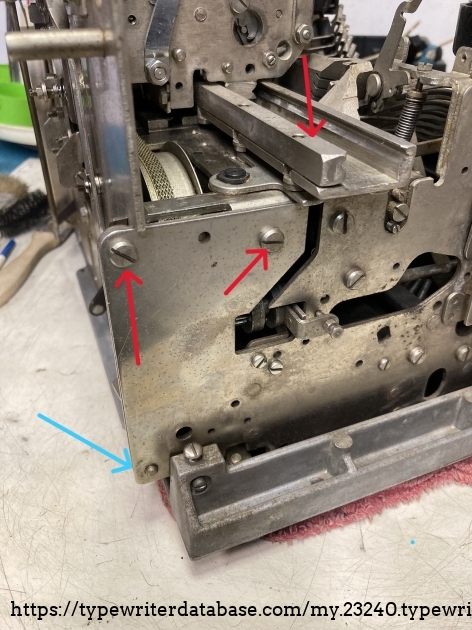https://dactylographe.home.blog/2019/10/13/reluctant-remington/
- Dec 2024
-
dactylographe.home.blog dactylographe.home.blog
-
typewriterdatabase.com typewriterdatabase.com
-
www.facebook.com www.facebook.com
-
typewriterdatabase.com typewriterdatabase.com
-
https://typewriterdatabase.com/196x-remington-superriter.23240.typewriter
Annotated photo of Remington's Fold-A-Matic screw locations.
-
-
writingball.blogspot.com writingball.blogspot.com
-
munk.org munk.org
- Jun 2024
-
coevolving.com coevolving.com
-
how such a system is born, itself, of a generative system, establishing the duality between the object as a computing agent and the method as a computational process.
-
Ultrastability places two sets of environmental and reactive variables in a primary feedback loop. A slower, second feedback affects the reactive variables by acting on the step-mechanisms and setting parameters for the environmental variables.
Also see "Above the line, Below the line" above.
-
unfolding
See slide 30/51 in:
-
Almost every ‘system as a whole’ is generated by a ‘generating system’. If we wish to make things which function as ‘wholes’ we shall have to invent generating systems to create them.
Alexander 2011, p. 59; Alexander 1968, p. 605
Tags
- computation
- fold
- helix
- unfolding
- generative
- systems
- method
- object
- double feedback
- process
- duality
- recursion
- ultrastability
Annotators
URL
-
-
queue.acm.org queue.acm.org
Tags
Annotators
URL
-
- Aug 2022
-
www.kevinmarks.com www.kevinmarks.com
-
https://www.kevinmarks.com/memex.html
I got stuck over the weekend, so I totally missed Kevin Marks' memex demo at IndieWebCamp's Create Day, but it is an interesting little UI experiment.
I'll always maintain that Vannevar Bush really harmed the first few generations of web development by not mentioning the word commonplace book in his conceptualization. Marks heals some of this wound by explicitly tying the idea of memex to that of the zettelkasten however. John Borthwick even mentions the idea of "networked commonplace books". [I suspect a little birdie may have nudged this perspective as catnip to grab my attention—a ruse which is highly effective.]
Some of Kevin's conceptualization reminds me a bit of Jerry Michalski's use of The Brain which provides a specific visual branching of ideas based on the links and their positions on the page: the main idea in the center, parent ideas above it, sibling ideas to the right/left and child ideas below it. I don't think it's got the idea of incoming or outgoing links, but having a visual location on the page for incoming links (my own site has incoming ones at the bottom as comments or responses) can be valuable.
I'm also reminded a bit of Kartik Prabhu's experiments with marginalia and webmention on his website which plays around with these ideas as well as their visual placement on the page in different methods.
MIT MediaLab's Fold site (details) was also an interesting sort of UI experiment in this space.
It also seems a bit reminiscent of Kevin Mark's experiments with hovercards in the past as well, which might be an interesting way to do the outgoing links part.
Next up, I'd love to see larger branching visualizations of these sorts of things across multiple sites... Who will show us those "associative trails"?
Another potential framing for what we're all really doing is building digital versions of Indigenous Australian's songlines across the web. Perhaps this may help realize Margo Neale and Lynne Kelly's dream for a "third archive"?
-
- Apr 2022
-
docdrop.org docdrop.org
-
Such radical compositional approaches arecontemporaneous with the Surrealist use of montage, but predateBurrough’s cut-up-fold-in technique, and ‘put[...] the avant-gardeclaims of hyperfiction to shame’ (Krapp, 2006: 362).
The compositional approaches mentioned here are those of Wittgenstein and Walter Benjamin.
What was Burrough's cut-up-fold-in technique?
-
- Apr 2017
-
static1.squarespace.com static1.squarespace.com
-
But these are also reductions that decline to grant the bridge its autonomy, its unique manner of holding sway in the world. Heidegger points out how the banks of a stream emerge as banks only as the bridge joins them; this happens because the banks show forth in a new relation
This is a helpful articulation, and makes me think back to Home; typically we would frame a "home" through the sentimental or material value it provides to the people living in it, but by moving erratically through time, we got to see the home as the thing itself--an assemblage that pulled together different parts of the world at different times. Because we were not able to "get to know" the humans who lived there well enough to really empathize or become engaged in their personal narratives, our attention was focused on the four-fold of the "home" as a thing itself.
-
